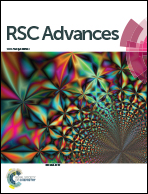Temperature- and pH-responsive properties of poly(vinylidene fluoride) membranes functionalized by blending microgels†
Abstract
A novel blend membrane with temperature- and pH-responsive properties was prepared by the physical blending of poly(vinylidene fluoride) (PVDF) bulk material, poly(N-isopropylacrylamide) (PNIPAAm) microgels and poly(acrylic acid) (PAA) microgels with a simple and practical procedure, which is suitable for industrial scale production. The composition and structure of the blend membrane were investigated by Fourier transform infrared spectroscopy (FT-IR), X-ray photoelectron spectroscopy (XPS) and field-emission scanning electron microscope (FESEM). The results indicated that the incorporation of PAA and PNIPAAm microgels improved the pore size, porosity and hydrophilicity of the blended membrane, leading to a higher water flux and remarkable antifouling property. In particular, the blend membrane exhibited temperature- and pH-sensitive characteristics. The dual responsive feature makes it easy to control the blend membrane’s rejection properties as well as the water flux and helps the membrane retain preferable mass transfer and separation property when responding to one of the investigated stimuli.


 Please wait while we load your content...
Please wait while we load your content...